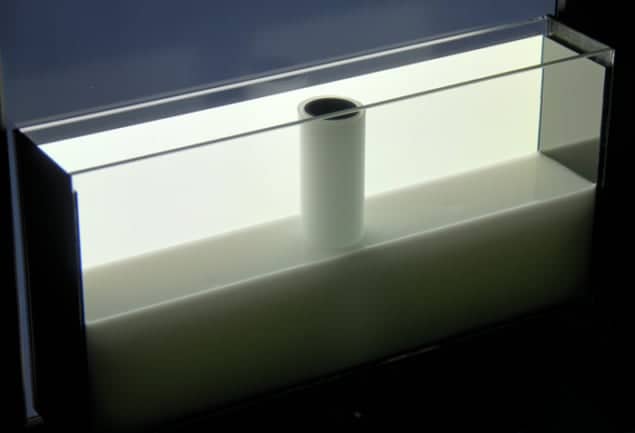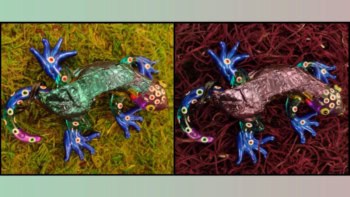
A new type of invisibility cloak that hides objects from light in diffusive media such as a cloudy liquid – rather than a clear medium such as air – has been unveiled by physicists in Germany. Based on the same physical principle used in cloaks that shield objects from heat, the device has been created by Robert Schittny and colleagues at the Karlsruhe Institute of Technology. Although applications of the device are limited, the researchers say that it could be used to create aesthetically pleasing yet burglar-proof glass.
Invisibility cloaks work by diverting light around an object in much the same way as water flows around a smooth stone in a gently flowing stream. The problem is that the diverted light takes a longer path than neighbouring beams of light that are not diverted, which means that the associated delay can reveal the presence of the object to an observer. The solution is to build a cloak in which the phase velocity of the diverted light exceeds the speed of light in the surrounding medium. Unfortunately, this can only be done for light over an extremely narrow band of wavelengths – and a broadband cloak would violate Einstein’s special theory of relativity.
The situation is different for light travelling through a diffusive medium such as water containing tiny particles. Instead of moving in a straight line at the speed of light, the light scatters its way through the medium at a much slower effective velocity. Therefore, it is possible to create a broadband cloak in which the diverted light travels substantially faster than light in the surrounding medium.
Core strengths
To make such a cloak, the team combined an opaque core – the object to be cloaked – surrounded by a diffusive shell made of silicone doped with particles that are about 10 μm in diameter. Two cloaks were made and tested: one was spherical and the other cylindrical. Calculations based on Fick’s diffusion equation revealed a simple relationship linking the dimensions of the shell to the diffusivities of the shell and the surrounding medium.
This allowed the team to create ideal spherical and cylindrical cloaks. The cylindrical cloak has an outer radius of about 2 cm and is about 0.4 cm thick. Its “diffusivity” – a measure of how quickly light moves through it – was nearly five times that of the surrounding medium of paint particles dispersed in water. The radius and thickness of the spherical cloak were about the same as the cylindrical shell but the different geometry means that its diffusivity need only be about three times that of the surrounding media.
The team tested its cloaks by placing them in a transparent-walled tank filled with the paint/water mixture. White light is shone through the tank from one side and an image is captured by a digital camera placed on the opposite side. When an uncloaked object is in the tank, its dark shadow is clearly visible. However, when the cloak is put in place, the shadow vanishes.
Although the cloaking is not perfect – some of the region containing the object actually appears slightly brighter than its surroundings – the cloak appears to work across the entire visible spectrum. Sebastien Guenneau of the Fresnel Institute in Marseille, France, who last year joined forces with Schittny to make a thermal cloak that hides an object from heat diffusing through a medium, says that the new research is “very nice work on cloaking for diffusion phenomena”.
Behind bars
While applications for the new cloak are limited, Schittny believes that the technology could be used to hide the presence of unsightly security bars or other structures in frosted glass of the type used in bathroom windows. However, this would not work in conventional frosted glass, which has etched surfaces and is clear in the bulk of the glass. The glass would instead have to be doped with scattering particles much like the silicone used to make the cloak itself.
The cloak is described in Science.




